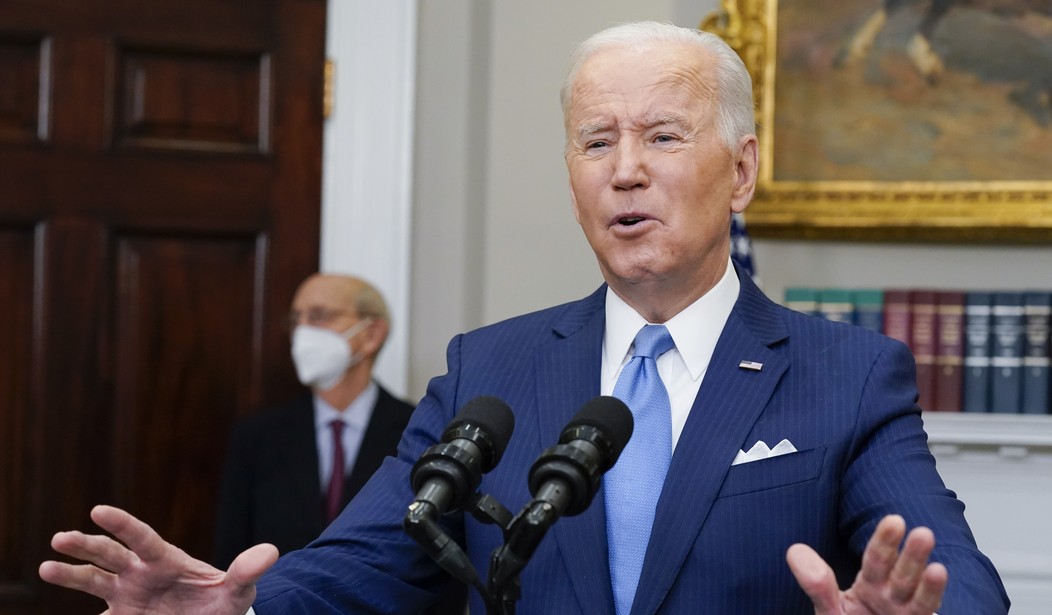Who do voters blame for inflation, especially at the gas pumps? It’s not Vladimir Putin, and they don’t chalk it up to “corporate greed” either. A pair of new polls identify who gets the blame for inflation and how much it will occupy voters in eight months — and again two years later, Fed chair Jerome Powell suggested yesterday.
We’ll get back to that projection at the end. The more significant of the polls comes from Emerson, whose polling has been a bit kinder to Joe Biden on job approval. He gets a 43/49 overall from Emerson, a slight improvement over last month’s 42/50. Among independents, however, both Biden and Democrats take a beating:
Spencer Kimball, Executive Director of the Emerson College Poll said, “Biden struggles among Independent voters: just 28% approve of the job he is doing while 64% disapprove. When looking at the Midterm generic congressional ballot, Independents break 28% for Democrats, 42% with Republicans, and 31% are undecided.”
Biden’s doing so bad that he’s making his predecessor look better:
Former President Trump has a nearly 12-point favorability advantage over Biden: 59% of voters say they are somewhat or very favorable of Trump, compared with 47% who are somewhat or very favorable of Biden. In a hypothetical 2024 election against former President Trump, Biden trails 45% to 42%.
If that’s the case, one has to wonder about the partisan skew of the sample. Independents have gotten increasingly disconnected from overall results in recent polling in a number of series, but the difference between 43/49 and 26/64 is rather eye-popping. The full results are downloadable in spreadsheet form, and it shows a D/R/I split of 37/36/27, which arguably gives a slight undercount to independents — but nothing that would explain that gap. Hmmm.
Biden has a bigger problem with inflation. Over eight in ten Americans now claim to be impacted by it, and about half of those blame Biden more than anything else:
Eighty-three percent (83%) of voters say they are experiencing some hardship due to increased prices on everyday items, with 40% reporting significant hardship, and another 43% reporting some hardship. Seventeen percent (17%) report experiencing no hardship. When asked about who they blame for an increase in gas prices, a plurality (39%) blame the Biden Administration, 21% blame the sanctions on Russia, and 18% blame gas and oil companies.
The chickens come home to roost on inflation, even among some Democrats, 13% of whom blame Biden most. A little over a third (34.5%) of Democrats buy the “Putin spike” argument on gas price increases, and only 22% blame the gas and oil companies. That’s not a sign of messaging victory even to the base. In contrast, 38% of independents and 67% of Republicans blame Biden for fuel inflation, although independents are slightly more inclined than Democrats to blame gas and oil companies (27.6%).
At Rasmussen, the consensus on blame is more substantial, in part because Rasmussen asked more specifically about it:
In the latest Rasmussen Reports survey, 64% of likely voters said that the president’s policies have caused the 40-year high rate of inflation. Just 8% said his actions have cut inflation, and 25% haven’t seen a difference. …
Rasmussen’s analysis added, “Majorities of every racial category — 67% of whites, 50% of black voters and 64% of other minorities — think the Biden administration’s policies have increased inflation. Eighty-eight percent (88%) of whites, 83% of black voters and 87% of other minorities believe the issue of inflation will be at least somewhat important in the November midterm elections.”
And it gets worse for Biden and Democrats when it comes to how it will weigh on their vote. Two-thirds of their respondents call inflation “very important” to their decision on how to vote in the midterms. Forty-two percent of Democrats think Biden made inflation worse rather than better (only 13%), and 82% of Democrats will base their vote at least somewhat on inflation.
This Washington Post analysis of who’s getting hammered hardest on inflation highlights the specific risk Democrats are running:
Rising prices are squeezing household budgets around the country and putting additional strain on its 56 million older residents ages 65 and up, many of whom rely on fixed incomes and limited savings to cover monthly costs for prolonged and unpredictable periods of time. Americans in that age range are more likely to live in poverty than younger adults are, Census Bureau data show, with wide disparities by age, race and circumstance, including whether they rely solely on Social Security or have other sources of income.
The burden on older Americans is the latest example of how inflation — at 40-year highs — is exacerbating inequalities across the economy. Higher prices on food, gas and housing are weighing heavily on those who can least afford it and creating new challenges for a population that is also most vulnerable to covid. Adding to the strain, millions of older Americans have given up regular incomes to retire during the coronavirus pandemic. …
“I feel like I’m going backward in time just to save $20 or $30 on my electric bill,” she said. “I take a very hot shower, but everything else — washing dishes, brushing my teeth — I do with cold water. And this time of year, it’s very cold.”
Morgan lives on a fixed income of about $35,000 a year, before taxes, roughly half of what she made when she was working. Her payments have been adjusted for inflation, she said, though the gains haven’t been enough to make up for actual costs, such as a 15 percent jump in monthly Medicare premiums that prompted her to opt out of the benefit altogether. She rarely buys meat anymore, and when she does, it’s canned chicken or a marked-down package of shrimp that she stretches into a week’s worth of stir-fry meals. Otherwise her meals are predictable: Oatmeal, eggs, pasta salad, toasted cheese sandwiches.
Who wants to run on the “make older people eat less meat through poverty” platform? It’s Jimmy Carter’s “malaise” speech on steroids. And yet, that’s exactly the environment Democrats have created, and what they will face in November 2022. And perhaps November 2024 too:
Powell pledged stronger Fed actions, including bigger increases in interest rates, to bring inflation under control. But given current conditions, he admitted that inflation is going to be around for a while. “As the magnitude and persistence of the increase in inflation became increasingly clear over the second half of last year, and as the job market recovery accelerated beyond expectations, the [Fed’s Federal Open Market Committee] pivoted to progressively less accommodative monetary policy,” Powell said. “I believe these policy actions and those to come will help bring inflation down near 2% over the next three years.”
Three years. That would be until early 2025. In between, we will have the 2022 midterm elections and the 2024 presidential election. And that is the political consequence of Powell’s speech.
By November 2022, voters will want a change. By November 2024, they might demand any alternative to Biden’s economic incompetence.








Join the conversation as a VIP Member